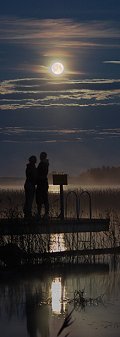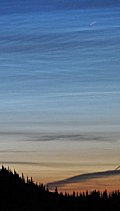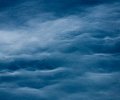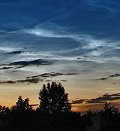| |
Observing
tips: Look
west 30 to 60 minutes after sunset when
the Sun has dipped 6o to 16o below the horizon.
If you see luminous blue-white tendrils spreading across the sky,
you've probably spotted a noctilucent
cloud. Although
noctilucent clouds appear most often at arctic latitudes, they have
been sighted in recent years
as far south as Colorado, Utah and Virginia. NLCs are seasonal,
appearing most often in late spring and summer. In the northern
hemisphere, the best time to look would be between mid-May and the
end of August. See also 2003,
2004, 2005,
2006 and 2007. |
 |
| |
| |
Photographer,
Location |
Images |
Comments |
|

[movie]
|
Derick
Rethans,
Skien, Norway
Jul. 16, 2008 |
#1,
movie,
more |
I
was far far away from my camera when I saw the Noctilucent
clouds first appearing. When I finally got home 2 hours
later they were still as bright, but disappearing. I set
my camera to take a picture every 30 seconds and created
this
movie out of it. |
|


|
P-M
Hedén,
Hedesunda Sweden
Jul. 18, 2008 |
#1,
#2, #3,
#4, more |
I
bought myself a little house in the deep forest outside
Hedesunda Sweden with some great nature and wildlife. I
was wondering if I could see Noctilucent clouds from there
and I got the answer the first clear nights. Some fantastic
displays of NLC! And in the south a lovely fullmoon with
Jupiter beside. Photos taken with a 20mm Sigma and a 450D
Canon |
|

|
Rick
Klawitter,
Hurricane Ridge, Olympic National Park, Washington
Jul. 19, 2008 |
#1 |
We've
seen NLCs on several occasions so far this July with the
brightest display on the eighth. This photo was taken last
night, July 19th from Hurricane Ridge in the Olympic Mountains.
They appeared at around 10:15 PDT and first seen 40 degrees
up in the north western sky. The clouds were not brightly
illuminated.
Photo
details: Nikon
D300, 102mm, f5.6, 8 second exposure, ISO 400. |
|

|
Austin
Taylor,
Lerwick, Shetland, UK
Jul. 18, 2008 |
#1,
#2, #3,
#4, more |
Sightings
of these clouds seem to be best in May and July in Shetland
and may be anticipated perhaps 3 or 4 times in an average
year here. This is already my 4th sighting this year but
sightings as brilliant as these are rare and they were a
truly beautiful sight - well worth the fuss they seem to
have generated. I thought the ones I saw in July last year
were spectacular but these ones put those into the shade
being brighter, covering a much more extensive area of sky
and having some incredible variety of shapes, lines and
wisps. I'm glad I stayed up!
Photo
details: Nikon
D200, Nikkor 18-200mm VR lens |
|

[movie]
|
Aigar
Truhin,
Sigulda, Latvia
Jul. 17, 2008 |
#1,
#2, #3,
#4, movie
|
There
were brightest clouds in this summer!!! Make pictures with
Canon S2 IS, 4 - 6 sek. exposure. Noctilucent clouds coming
from north and then moving to the east. And with morning
sun disappeared. |
more
images (July 19): from
Denis Fell of Wetaskiwin, Alberta, Canada; from
Liem Bahneman of Bothell, Washington
more
images (July 15): from
Paul Reed of Brough, East Yorkshire, UK
|
|
|







